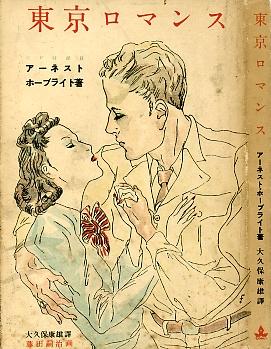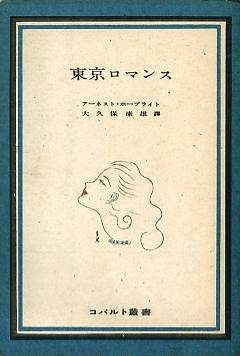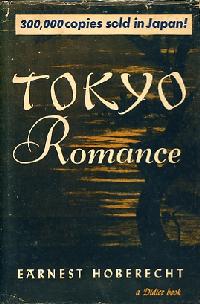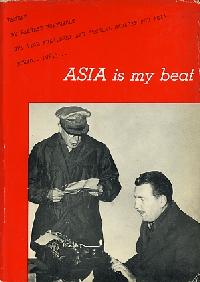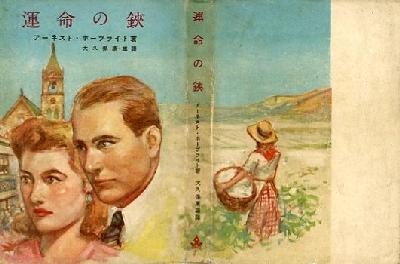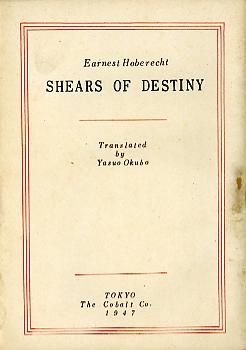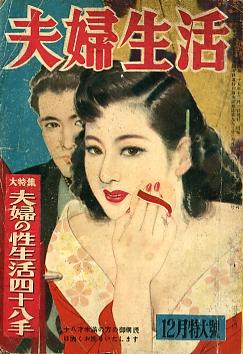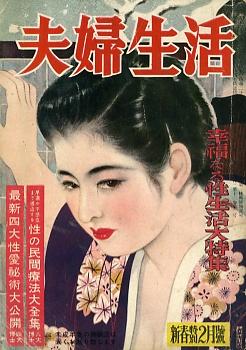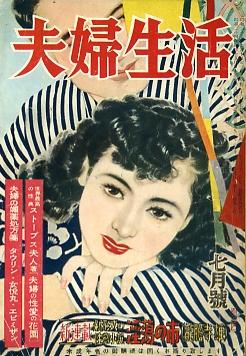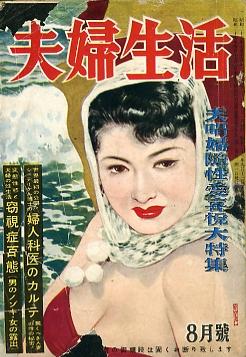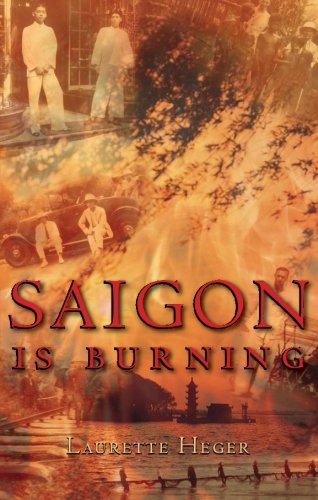Earnest Hoberecht
The journalist who wanted to fly
By William Wetherall
First posted 15 August 2006
Last updated 31 October 2020
Earnest HoberechtThe journalist who wanted to flyEarnest Trevar Hoberecht, Jr. (1918-1999) was born in Watonga, in Blaine County, Oklahoma, on 1 January 1918, the son of Grace B. Hoberecht (1891-1956) and Earnest T. Hoberecht, Sr. (1889-1968), and he passed away on 22 September 1999. He is buried, as are his parents, in the Hoberecht plot in Watonga IOOF Cemetery. Hoberecht married Laurette Helene Heger (1937-2015), a French national born in Saigon, in New Delhi, India, on 6 May 1959. See Laurette Helen Heger at the end of this article for a look at her life and a review of her 2006 book, Saigon Is Burning, an account of Southeast Asia during the Pacific War. Japan as seen by American correspondentsEarnest Hoberecht, well known among contemporary journalists in Asia as the United Press International (UPI) man in the region during and after the Pacific War, is best remembered today for the way he helped indoctrinate postwar Japanese society with (presumably) American attitudes toward marriage and sex. Before he took it upon himself to play this role, however, he contributed to a bilingual booklet published in March 1946, barely half a year after Japan's surrender and the start of the Allied Occuption in September 1945. Hoberecht was the lead-off writer among six American journalists who were asked by Mainichi Shimbun (毎日新聞), one of Japan's major national daily newspapers, to write a short impression of Japan, Japanese colophon毎日新聞社 (編者) The Japanese title reads "Amerika tokuha-in no mita Nihon inshōki" or "A chronicle of impressions of Japan as seen by American (special, foreign) corrspondents". The booklet was printed on 15 March and published on 20 March 1946. The stated price was 1 yen 50 sen. English particularsThe Mainichi Publishing Company (editor) The booklet is printed on pulp paper and bound in B6 size with a single staple in the middle of the spine. Hoberecht's contribution -- "Upon arriving in Japan by air" in English and "Sora kara no dai-ip-po" (空からの第一歩) or "The first step from the air" in Japanese -- consumed 6 pages in English and 4 in Japanese (see images to the right). Tokyo RomanceAanesto Hooburaito [Earnest Hoberecht] Earnest Hoberecht Fifty Famous AmericansAanesto Hooburaito [Earnest Hoberecht] Asia Is My BeatEarnest Hoberecht Earnest Hoberecht (1918-1987) was, by all accounts, a character. He appears to have been the sort of colorful journalist that didn't learn his trade in a J school. He was also a proud Oaklahoman and romantic who wanted very much to be a novelist. For a few years in Japan right after the Pacific War -- until James Michener visited the country in the early 1950s and set the record straight -- many Japanese were under the impression that Hoberecht was another Hemingway, Faulkner, Lewis, Fitzgerald, or Buck. Asked what he thought of Hoberecht, Michener told a gathering of college students that he had not been able to "keep up with the younger German writers" (Newsday, 1957). The audience laughed, and afterward a graduate student, who was writing a thesis to prove that Hoberecht was America's greatest novelist, told Michener he was surprised he didn't know that Hoberecht was an American. Had Hoberecht (pronounced "hobright") not followed MacArthur to Japan at the end of the Pacific War as a United Press correspondent, the world would probably never have known about his aspirations to write fiction. As it is, the world, its memory mercilessly (or mercifully) short and selective, can barely recall Hoberecht's name, much less the titles of the two novels he published in Japanese -- the first of which outsold by a factor of ten its later English edition. The second, which Hoberecht had written much earlier and was prouder of, has never seen the light of day in English. 28 October 1946 Time reviewTime Magazine reviewed Tokyo Romance in its 28 October 1946 issue. The review can be retrieved from TIME Archive on Time's website. I have also reproduced it here. Nipponese Best-Seller Posted Monday, Oct. 28, 1946 A United Press correspondent in Tokyo named Earnest Hoberecht had time on his hands. Nobody in Japan, he noted, had written a Hucksters, an Egg & I or an Amber for the postwar Japanese trade. He decided to do it himself. Last week a Tokyo publisher brought out the result, a richly corned-up novel called Tokyo Romance. It had a U.S. correspondent for a hero, a Japanese movie queen for a heroine, a faint flavor of Madame Butterfly, a happy ending. Overnight, it became a bestseller: booksellers gobbled the first printing (100,000 copies), and yelled for more. Author Hoberecht's plot was simple, sentimental and surefire: in captured Jap strongholds in the Pacific, War Correspondent Kent Wood found faded pin-up pictures of an almond-eyed cinema star (who looked a lot like Movie Actress Yetkiko [Yukiko] Todoroki, good friend of the author). Later, in Tokyo, they met and fell in love. But they had to woo in secret, for her studio forbade fraternization. When another correspondent was murdered by a former Nazi spy, Hero Kent Wood was suspect. His girl friend tossed away her chance for a big role by confessing that she was with him at the time of the murder. She was fired, married her American and they went honeymooning at Atami hot springs. A telegram came from her studio: in view of her "democratic sacrifice," all was forgiven, and the big role was hers after all. Fadeout. Quivering Detail. Most of the action took place at the "Tokyo Correspondents' Club" at No. 1 Shimbun Alley, the official billet for foreign correspondents. Hoberecht got most of its residents, and even its houseboys, between his covers. Added attraction: some sensuous illustrations by Artist Tsuguharu Fujita, billed as the first kissing scenes ever to adorn a Japanese novel. Since Japanese are unaccustomed to Western-style embraces, Hoberecht went into what he calls "great, quivering detail." (To one hot-blooded chapter the publishers added a solemn subtitle: The Ethics of Kissing) Last week, as his royalties piled up from Tokyo Romance (240 pp., 18 yen or $1.20), Hoberecht was rolling in yen -- which he could not spend outside Japan. A publisher was hounding him for rights to an English-language edition. (Hoberecht wrote his book in English, got a Japanese friend to have it translated.) A Tokyo newspaper wanted to run the book as a serial, and two of Japan's three leading cinemakers were bidding for the screen rights. If he were asked to play the hero's role, said Hoberecht, he "probably wouldn't refuse." And he certainly would want to pick the leading lady. From the Oct. 28, 1946 issue of TIME magazine Todoroki Yukiko played Sayo in Kurosawa Akira's "Sugata Sanshiro" (1943) and "Zoku Sugata Sanshiro" (1945). She also appeared in Mizoguchi Kenji's "Musashino Fujin" (1951) and Ichikawa Kon's "Seishin kaidan" (1955), among other films. Perfect love story for early postwar JapanTokyo Romance reads more like a plea for ending taboos about mixed marriage than as a novel. It is so boring that one can't put it down -- simply out of curiosity about how an obviously competent writer of reportage handles plot and character. The ultra simplicity of the story -- of true love between an American journalist with a jeep and Japan's most popular movie star -- makes it ideally suited as a guidebook for readers who want to know what American-style love is all about, at least in Japan. As a result of the novel's popularity, Hoberecht became a celebrity. Another novel (see below), and a non-fiction work on famous Americans, were published in Japanese, and a number of men's and women's magazines asked him to contribute his views on Japanese and American love and marriage (see below). Okubo YasuoHoberecht's "plagiarist"Hoberecht's partner in literary crime was Okubo Yasuo (1905-1987), a student of English literature and a translator, and one of Japan's most popular translators at the time. Okubo is most famous for for his translation of Margaret Mitchell's Gone With the Wind (1936) as Kaze to tomo ni saranu in 1938 the year before the release of the movie. James Michener, in a 1957 Newsday story about Hoberecht (see below), quoted Hoberecht as describing Okubo as "the young man in Tokyo who plagiarized Gone with the Wind. Very gifted boy. I employed him to work on my books, and all the skill he had applied to his plagiarism he applied to my work." Edward Seidensticker has characterized translators as "counterfeiters" but "plagiarists" may be the more fitting metaphor. Gone With the WindGone With the Wind has been a screen, stage, and manga favorite in Japan since the end of the Pacific War. Okubo translated Margaret Mitchell's 1936 novel as Kaze to tomo ni sarunu. This translation was published in three volumes by Mikasa Shobo in 1938, the year before the movie came out in the United States. Kaze to tomo ni sarunu has been a staple in the repertoire of the all-female Takarazuka Revue since the company produced its first musical adatation of the story in 1977. Every production has been cast and arranged differently. In the first Takarazuka production, the main character was Rhett Butler, appropriately played by Haruna Yuri, the most popular star at the time, known for her strong male performances, and made up to look very much like Clark Gable, who got top billing in the film. But many later productions have cast the top star as Scarlett O'Hara, who is the main protagonist in the the novel. Okubo's translation is still in print. It's publishing history is somewhat interesting. In 1949 Mikasa reissued the translation in five volumes as the first work in the "Eibeihen" group of its "Gendai sekai bungaku" series. Only Okubo's names as given as translator. In 1952 Mikasa put out a scenario of the movie with 16 pages of stills, showing Okubo Yasuso as the "supervising editor" (kanshu). In 1953 Mikasa published Okubo's translation as a boxed two-volume "bekkan" (supplement) of its Gendai sekai bungaku zenshu. In 1955 Mikasa published a boxed six-volume edition in "shinsho" (taller pocketbook) size, showing for the first time Takeuchi Michinosuke's name alongside Okubo's as translator. In 1977 Mikasa released a three-volume version showing both Okubo Yasuo and Takeuchi Michinosuke as translators. Grapes of WrathOkubo translated some of the most popular works of the most popular writers, including O'Henry, Ellery Queen, Agatha Christie, John Steinbeck (Grapes of Wrath), Daphne du Maurier (Rebecca), Sir Arthur Conan Doyle, Mark Twain (Tom Sawyer), Vladimir Nabokov (Lolita), William Faulkner (The Wild Palms), Charlotte Bronte (Jane Eyre), Ernest Hemingway (The Sun Also Rise, Farewell to Arms, For Whom the Bell Tolls), Margaret Mitchell (Gone Withthe Wind), and Henry Miller (Tropic of Cancer, Tropic of Capricorn), among others. Okubo translated Grapes of Wrath (1939) as Ikari no budo [Graphs of wrath] (Hayakawa Shobo, 1967) -- fifteen years after he translated Shears of Destiny, Hoberecht's fictional effort to correct Steinbeck's images of Oaklahoma (see below). Day of InfamyOkubo also translated a few non-fiction works, including Walter Lord's Day of Infamy (1957). Hametsu no hi: Junigatsu yoka no Shinjuwan [Day of destruction: Pearl Harbor on December 8] (Hayakawa Shobo, 1957) came out in Japan the same year it became a bestseller in the United States. |
Foujita's illustrationsThe Japanese edition of Tokyo Romance includes nine full-page illustrations drawn by Foujita Tsuguharu (1886-1968). They are dispersed throughout the story but more frequently toward the end. While encountered in the book while reading right to left, the pictures are shown here left to right. Though printed on yellowing pulp paper, the drawings are much sharper than they appear in these scans. |
||
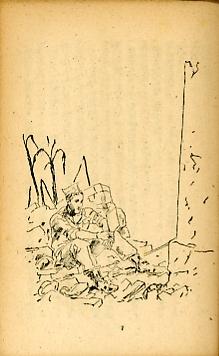
|
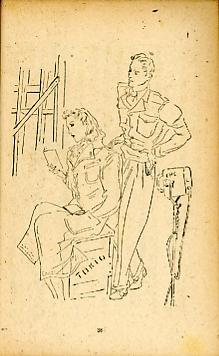
|
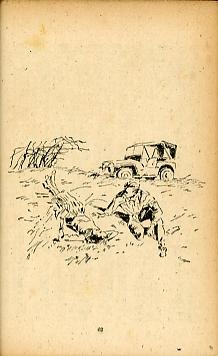
|
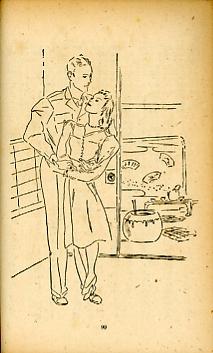
|
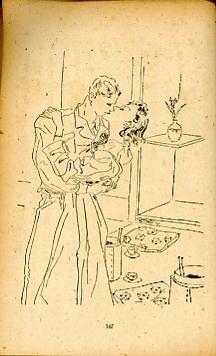
|
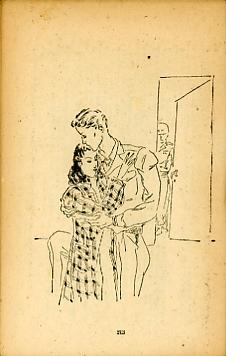
|
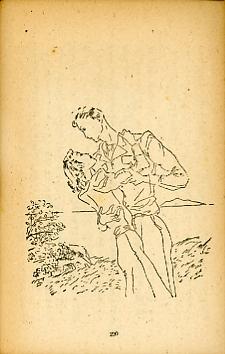
|
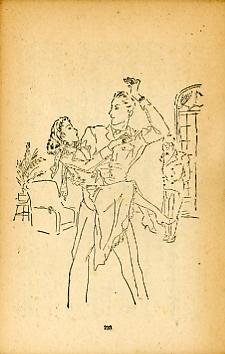
|
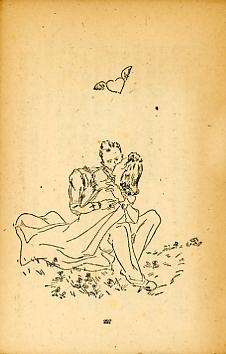
|
Shears of DestinyAanesto Hooburaito [Earnest Hoberecht] Hoberecht claims he was motivated to write Shears of Destiny as a refutation of the images John Steinbeck created of the "Okies" who leave Oaklahoma for California during the dust-bowl years of the Great Depression, in his novel The Grapes of Wrath (1939), which won him a Pulitzer Prize in 1940 and the Nobel Prize in 1962. James Michener reports Hoberecht's account of how this novel came to be written in the 1957 Newsday interview he published after meeting Hoberecht in Japan (purple emphasis added). My next novel [published in Japanese after Tokyo Romance] is probably the finest thing I ever did and I'm deeply sorry it had to be published in Japanese because it's a book Americans ought to read. It clears up some very misleading matters. It's called Shears of Destiny. I wrote it long before the war and couldn't find an American publisher, being then just an unknown, and it turned up in the box of old papers my father shipped me. I had it translated by the plagiarizer [Okubo Yasuo] right into Japanese without additional editing because it was a well constructed story just as I told it and I had already gone over it once when I sent it to the American publishers. The Japanese loved it and it made a lot of money. I think Americans would go for it, too, but now it's enshrined as a part of Japanese literature. In it I prove that the Okies written about by John Steinbeck didn't come from Oklahoma at all. They were mostly from Georgia, a very poor sort of people, with some useless Texa[n]s and some no-goods from Mississippi thrown in. They just happened to be passing through Oklahoma and if Steinbeck had taken the trouble to study the facts a little deeper he'd have realized that he wasn't writing about Okies at all but about these no-goods from other states. I'm not criticizing Steinbeck, you understand. Does no good for one literary man to knife another, but I did have to write this book to clear Oklahoma of the unfair stigma Steinbeck's book had cast upon my state. The harm done by one book like Steinbeck's outweighs all the good of a musical like Oklahoma. Divine retributionSome communities in the United States have at times banned Grapes of Wrath from libraries and schools and even made possession of the novel a crime. As soon as it was published, it was banned in Kern County, California, where much of the story is set. By the time Hoberecht died in 1999, some scholars had begun to undermine the credibility of Grapes of Wrath as a work of social history, which is how is has usually been read in schools -- though for reasons unlike those Hoberecht gave Michener. Steinbeck was not, however, the only one to embrace the images of Oaklahoma and Okies he disseminated in his novel. A number of contemporary works, like An American Exodus: A Record of Human Erosion (New York: Reynal & Hitchcock, 1939), a photographic essay by Dorothea Lange and Paul S. Taylor, cultivated the soil in which it was possible for Americans to read Grapes of Wrath as an accurate portrait of the times. Earnest Hoberecht, as proud an Oaklahoman as was ever born, read it very differently. |
Tokyo Romance was translated into Spanish, and at least three differently designed editions were published as Romance en Tokio between 1950 and 1958. Scans and other particulars forthcoming. |
Hoberecht as a media celebrityPublishing in Japan was increasing suppressed for political reasons during the years leading up to the Pacific War. Printed matter was more heavily censored during the war, and further constrained by paper shortages that briefly continued after the war. Liberated from such limitations, newspaper, magazine, and book publishers scrambled for paper, ink, and presses to meet the demand for information and entertainment, subject only to the more permissive content rules set down by the Occupation government. Japan's publishing industry, one of the healthiest in the world before World War II, quickly recovered, and it went on to be what -- but the end of the 20th century -- could probably boast as having the highest per-capita rate of print media consumption in the world. As of this writing, nearly two decades into the 21st century, Japan's print media is rapidly giving way to the inroads made by Internet media. Television did not begin to spread until the mid 1950s, and so popular magazines, novels, and movies were the main sources of entertainment during the late 1940s and into the 1960s, when Earnest Hoberecht became a celebrity writer in Jaan. The Japanese translations of the fictional Tokyo Romansu (1946) and "Unmei no hasami (1947) were, and the ,,,夫婦生活,,昭和25年12月特大号,東京,夫婦生活社,1950,1950,,m,j,s,p,p,\,2000 アーネスト・ホーブライト 丸木砂土 竹村文祥ほか 昭和25年12月1日発行 日本人夫婦よ、人前でもつと愛情を UP通信東京支局長 アーネスト・ホーブライト ,,,夫婦生活,,昭和26年新春特別2月号,東京,夫婦生活社,1951,1951,,m,j,s,p,p,\,2000 鈴木義一 E・ホーブライト 堀秀彦ほか ,,,夫婦生活,,昭和26年4月号,東京,夫婦生活社,1951,1951,,m,j,w,p,p,\,2000 昭和26年4月1日発行 愉しいデイティングと夫婦生活 UP支局長 アーネスト・ホーブライト ,,,夫婦生活,,昭和26年7月号,東京,夫婦生活社,1951,1951,,m,j,s,p,p,\,2000 堀秀彦 長田幹彦 E・ホーブライトほか ,,,夫婦生活,,昭和26年8月号,東京,夫婦生活社,1951,1951,,m,j,s,p,p,\,2000 アーネスト・ホーブライト 小西茂也 長田幹彦 Magazine articlesHere is a list of some of Hoberecht's Japanese magazine articles. きものの話ー古典の美しさを新しく着る技術(西崎緑) 表紙・高井貞二、カット・亀倉雄策、鷹山宇一きものの話ー古典の美しさを新しく着る技術(西崎緑)小さな愛の家(案・梅田三勝 画・高井貞二)プラトニック・ラヴ論(河盛好蔵)性病とのたたかい(森山豊)パリジャンヌのはなし・1 ラ・ロシュフフコオ公爵夫人(キク・ヤマタ)埋火(清水基吉 画・三岸節子) アーネスト・ホーブライト
大久保康雄 (訳) ホーブライト The following Japanese editions of books by Earnest Hoberecht are listed in databases. October 1946 April 1947 The frontispiece preceding the author's brief foreword about the Oklahoma origins of his novel shows him holding a copy of Evelyn Waugh's Brideshead Revisited, which was published in 1945. 1947 1948 1948 |
1999 The New York Times obituaryEarnest Hobertecht rated a 926-word obituary by Douglas Martin at the Metropolitan Desk in the Sunday, 26 September 1999 edition of The New York Times, as follows.
2015 Number 1 Shimbun tributeThe Foreign Correspondents Club of Japan (FCCJ) paid tribute to Earnest Hoberecht in the March 2015 issue of the monthly magazine Number 1 Shimbun, as copied and reformatted below. The "Shimbun Alley" was the name of the side street where FCCJ set up operation during the Allied Occupation of Japan. Practically all contemporary journalists who filed reports from its facilities are alive as I write this today in 2019. However, the legends are still being whispered among the few younger journalists who heard them directly from the few contemporaies who were still in town shortly after the turn of the 20th to 21st centuries.
|
Laurette Helene HegerTokyo Romance was translated into Spanish, and at least three differently designed editions were published as Romance en Tokio between 1950 and 1958. Hoberecht married Laurette Helene Heger -- a French national born in Saigon, in French Indo-China, on 10 August 1937 -- in New Delhi, India, on 6 May 1959. The first two of their four children, Antonia Grace Hoberecht and Earnest Hoberecht III, were born in Yokohama in 1960 and 1962. Their mother was admitted to the United States as a permanent resident at Honolulu, Hawaii, on 21 December 1962, and she petitioned for naturalizion in Houston, Texas on 21 January 1963. She was admitted to U.S. citizenship on and passed away on 22 June 2015 in Tulsa, Oklahoma. Laurette Helene Heger's obituary states that three of her children with Earnest were born in Japan, but her 1962 petition for naturalization lists only two, the youngest of whom -- Ernie III -- was born only 6 months old when the Hoberechts left Japan and only 7 months at the time the petition was filed. The couple apparently divorced before 1971 when Laurette reportedly married a Don Church, with whom she is said to have had a daughter, presumably her fifth child. The obituary gives the impression that she reverted to her natal family name after Church died. See Laurette Helen Heger at the end of this article for the story of Laurette Heger's life and a look at her 2006 book, Saigon Is Burning, an account of Southeast Asia during the Pacific War. |
